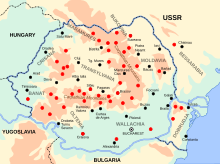Romanian anti-communist resistance movement
| Romanian anti-communist resistance movement | |||||||
|---|---|---|---|---|---|---|---|
| Part of Eastern European anti-Communist insurgencies | |||||||
 Map of Romania with armed resistance areas marked in red |
|||||||
|
|||||||
| Belligerents | |||||||
|
|
|
||||||
| Commanders and leaders | |||||||
|
Full List Below... |
|
||||||
| Strength | |||||||
| 10,000 rebels | |||||||
| Casualties and losses | |||||||
| ~2,000 Killed | Unknown, but most likely light. | ||||||
The Romanian anti-communist resistance movement was active from the late 1940s to the mid-1950s, with isolated individual fighters remaining at large until the early 1960s. Armed resistance was the first and most structured form of resistance against the communist regime. It wasn’t until the overthrow of Nicolae Ceauşescu in late 1989 that details about what was called “anti-communist armed resistance” were made public. It was only then that the public learnt about the several small armed groups, which sometimes termed themselves "haiducs", that had taken refuge in the Carpathian Mountains, where some hid for ten years from authorities. The last fighter was eliminated in the mountains of Banat in 1962. The extent and influence of the movement is often exaggerated in the post-Communist Romanian media, memoirs of the survivors and even historiography, while the authoritarian, anti-Semitic and/or xenophobic ideology of part of the groups is generally overlooked or minimized. The Romanian resistance is sometimes claimed to be one of the longest lasting armed movements in the former Soviet bloc.
In March 1944, the Red Army set foot in Bukovina advancing into Romanian territory, at the time an ally of Nazi Germany. Hundreds of people went into the forests forming anti-Soviet guerrilla groups of 15-20 people.
After the Allied armistice with Romania (11–12 September 1944), the Red Army had free run in Romania and the Romanian government did not have authority over Northern Bukovina. In late 1944 and early 1945, some small armed groups were formed in Romania, with a mission of harassing the Red Army in a future war between the Soviets and the West. After the war, most of these groups dissolved while others remained in the mountains until 1948, when they became active. In May 1946, General Aurel Aldea, the former Minister of the Interior of the Sănătescu government, was arrested and charged with "bringing together various subversive organisations under his command". It appears, however, that the "National Resistance Movement", which he coordinated, posed little threat, if any, to the establishment of the communist regime.
...
Wikipedia
